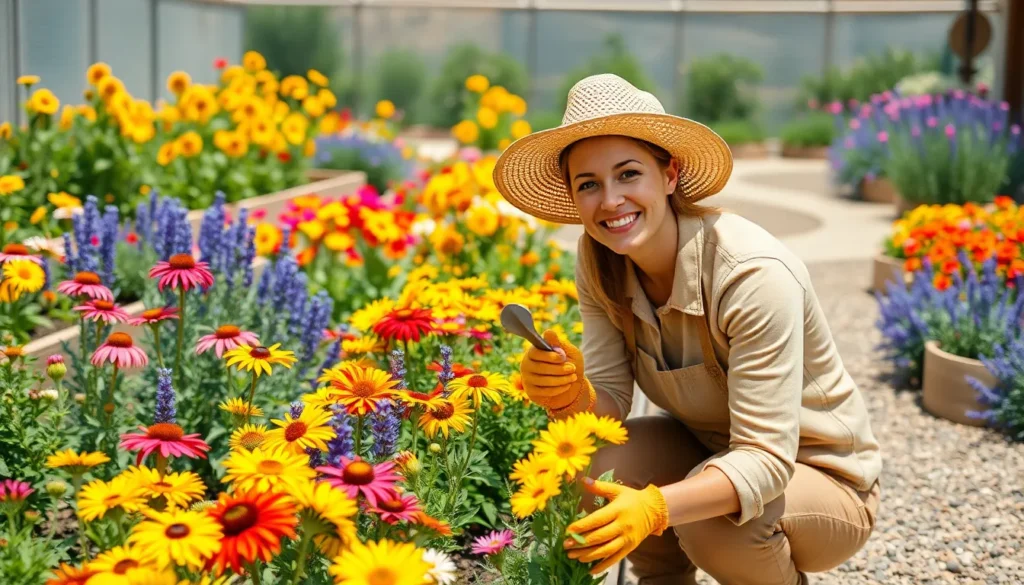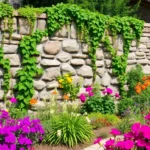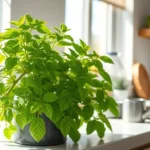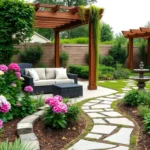Creating a stunning flower garden transforms any outdoor space into a vibrant sanctuary that captivates the senses and boosts your property’s curb appeal. Whether you’re working with a sprawling backyard or a cozy corner plot, the right flower garden design can turn your vision into a breathtaking reality that blooms throughout the seasons.
We’ve discovered that successful flower gardens aren’t just about planting pretty blooms – they’re about strategic planning that considers color schemes, bloom times, and maintenance requirements. From cottage-style gardens bursting with wildflowers to structured perennial borders that provide year-round interest, there’s a perfect approach for every gardener’s skill level and aesthetic preference.
Today we’ll explore proven flower garden ideas that’ll help you create an outdoor masterpiece that neighbors will envy. These design concepts work for beginners and experienced gardeners alike, offering practical answers that deliver maximum visual impact with manageable upkeep.
Choose the Perfect Location for Your Flower Garden
We’ll transform your outdoor space into a thriving flower haven by selecting the ideal location first. The right spot sets the foundation for healthy plant growth and stunning visual impact.
Assess Sunlight Requirements
Full sun areas receive 6-8 hours of direct sunlight daily and support vibrant blooms like marigolds, zinnias, and sunflowers. We recommend measuring sunlight exposure throughout different seasons since tree canopy changes affect light patterns.
Partial sun locations get 4-6 hours of morning or late afternoon light and accommodate versatile flowers such as impatiens, begonias, and coleus. These spots work perfectly for gardeners dealing with nearby structures or mature landscaping.
Shade gardens thrive in areas with less than 4 hours of direct sunlight and showcase beautiful options like hostas, caladiums, and ferns. We’ve found that morning sun combined with afternoon shade creates optimal conditions for many shade loving varieties.
Evaluate Soil Drainage
Well draining soil prevents root rot and supports healthy flower development in most garden varieties. We test drainage by digging a 12 inch hole and filling it with water to see if it drains within 24 hours.
Clay soil areas retain moisture longer and benefit from organic matter additions like compost or aged manure. These locations suit moisture loving flowers such as astilbe, cardinal flower, and bee balm.
Sandy soil spots drain quickly but require frequent watering and nutrient supplementation for optimal flower production. We recommend drought tolerant varieties like lavender, sedum, and black eyed susan for these conditions.
Raised bed answers solve drainage problems in challenging locations and give us complete control over soil composition. These elevated gardens work especially well for root vegetables mixed with companion flowers.
Consider Accessibility and Visibility
High traffic viewing areas near patios, walkways, or windows showcase your flower garden’s beauty throughout the growing season. We position our most colorful and fragrant varieties in these prime spots for maximum impact.
Maintenance accessibility ensures we can easily water, weed, and deadhead flowers without trampling nearby plants. Garden paths should be at least 2 feet wide and positioned every 4 feet in larger flower beds.
Utility line clearance prevents costly damage during future landscaping or home improvement projects. We contact local utility companies to mark underground lines before breaking ground on any new flower garden location.
Seasonal visibility considers how your flower garden appears from indoor living spaces during different months of the year. Winter interest becomes important in climates where outdoor entertaining extends beyond traditional growing seasons.
Plan Your Garden Layout and Design
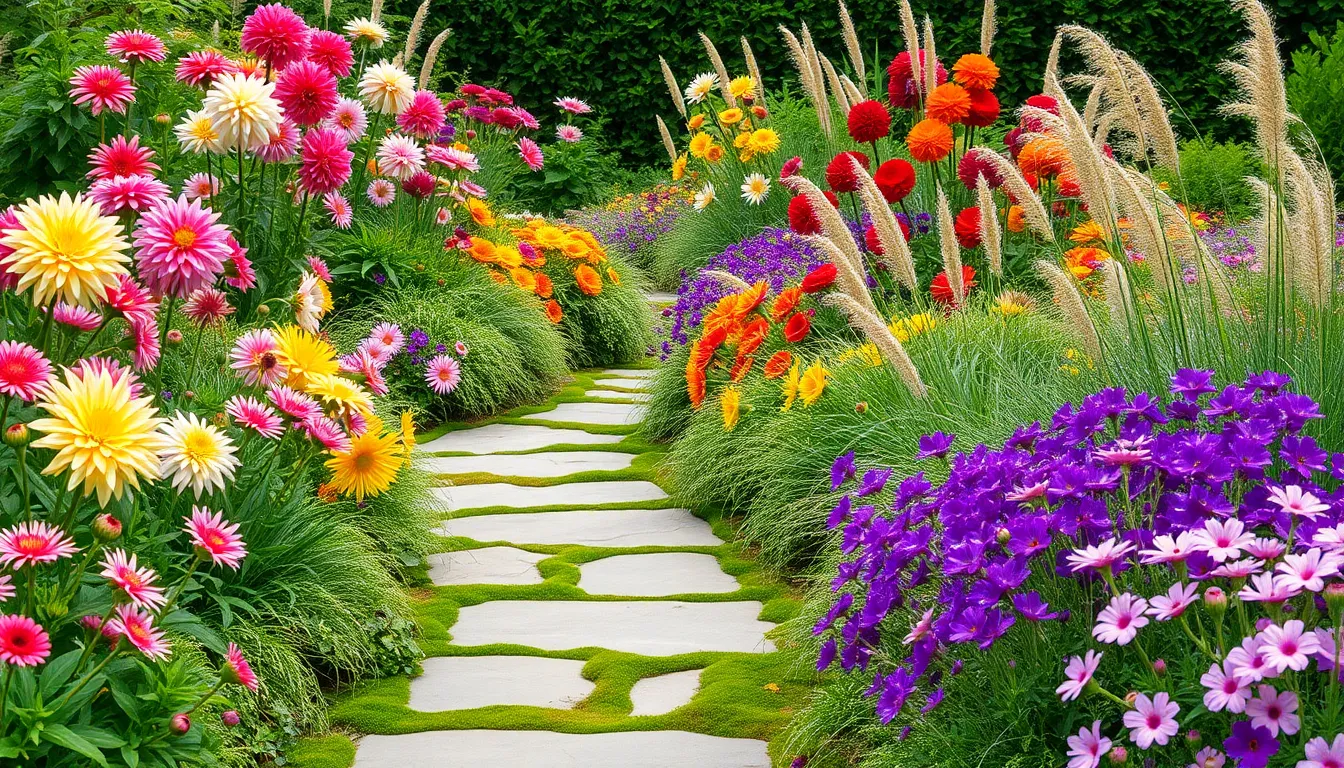
Smart garden layouts transform ordinary spaces into stunning displays. We recommend starting with simple geometric shapes like rectangles or gentle curves that provide visual appeal while ensuring practical access for maintenance.
Create Focal Points and Pathways
Anchor points give our gardens structure and draw visitors through the space naturally. We position specimen plants, garden sculptures, or architectural elements as centerpieces that capture attention from multiple viewing angles.
Pathways connect these focal areas while providing essential access for garden care. Limestone paths with soft, irregular edges create an organic feel that complements natural plantings. We line these walkways with Irish moss or similar groundcovers to soften transitions between hardscape and planted areas.
Materials like gravel, stepping stones, or decorative mulch work well for different garden styles. Consider maintenance requirements when selecting pathway materials, as some options need regular refreshing while others provide long term durability.
Design Seasonal Color Schemes
Year round interest requires strategic plant selection with staggered bloom times. We choose varieties that flower at different periods, ensuring vibrant displays from early spring bulbs through late fall chrysanthemums.
Coordinating plant selections creates continuous color rather than sporadic bursts followed by empty periods. Expert flower bed designs emphasize combining early, mid, and late season bloomers within each garden area.
Both annuals and perennials serve important roles in sustained color schemes. Annuals provide intense, season long blooms while perennials return reliably each year with less replanting effort. We balance these plant types to achieve both immediate impact and long term garden establishment.
Incorporate Height and Texture Variations
Layered plantings create visual depth that makes gardens appear larger and more interesting. We position tall flowers like dahlias or cosmos at the back of borders or in bed centers, while shorter varieties such as snapdragons fill front edges where they won’t be overshadowed.
Varying plant structures prevents monotonous appearances that bore viewers quickly. Shrubs provide permanent framework, ornamental grasses add movement and sound, while groundcovers fill gaps and suppress weeds naturally.
Different leaf shapes, bloom sizes, and growth habits contribute to ever-changing garden compositions. We mix broad hostas with narrow iris foliage, rounded hydrangeas with spiky salvias, and cascading petunias with upright marigolds to create captivating contrasts throughout our planted areas.
Select Flowers Based on Your Climate Zone
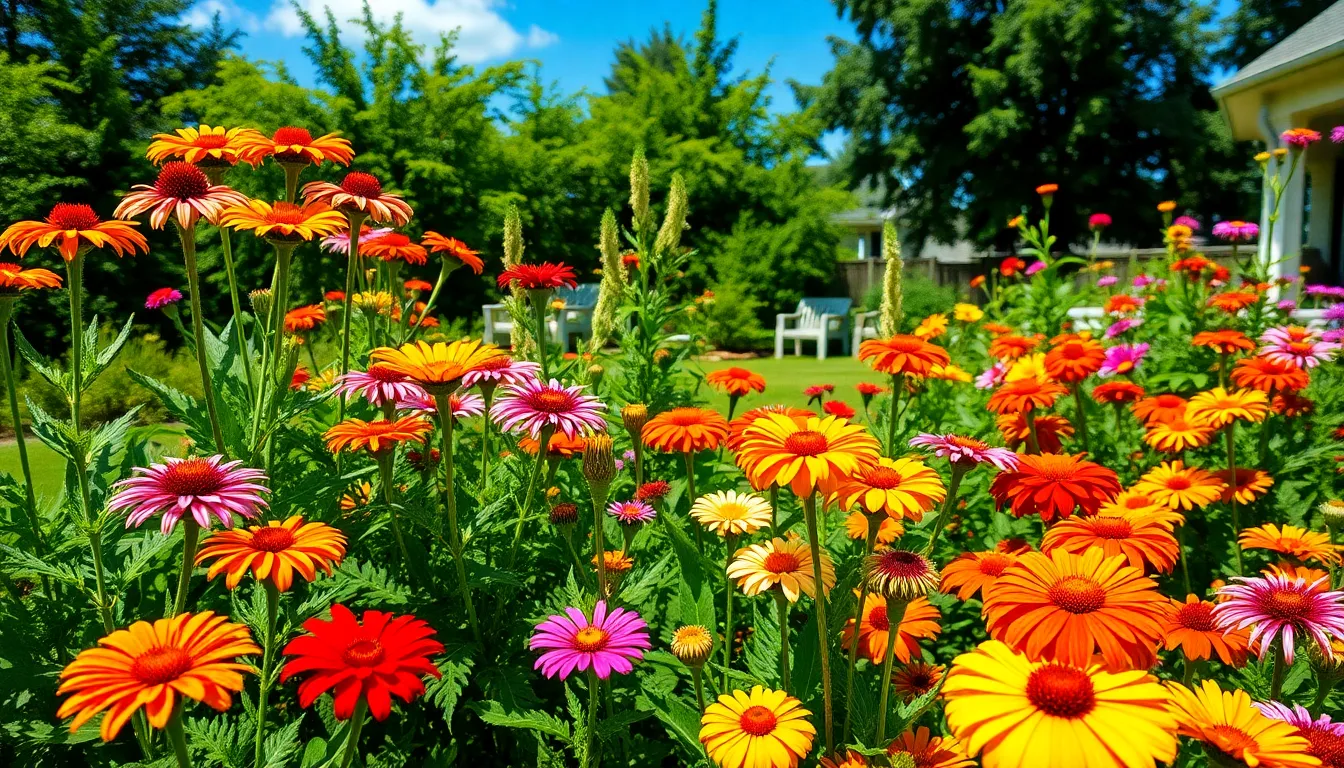
Choosing flowers that thrive in your exact climate zone ensures garden success and reduces maintenance frustration. We recommend using the USDA Plant Hardiness Zone Map to identify your region’s average annual minimum winter temperatures before selecting any plants.
Research Hardy Perennials for Your Region
Hardy perennials return year after year and withstand your area’s climate extremes without replanting. We find these plants offer excellent long-term garden structure while reducing annual costs and labor. Zone 5 regions experience average minimum temperatures between -20°F and -10°F with frost-free growing seasons from late April to early October.
Popular hardy perennials include coneflowers, daylilies, hostas, and black-eyed Susans depending on your exact zone. Each variety provides reliable blooms and foliage that adapt to local weather patterns. We suggest consulting your local extension service for zone-exact plant lists that guarantee regional success.
Choose Appropriate Annual Varieties
Annuals bloom for a single growing season and provide vibrant color throughout summer months. We select these flowers knowing they’ll need replanting each year but offer continuous blooms and design flexibility. Temperature ranges and growing season length in your zone determine which annual varieties will flourish.
Marigolds, petunias, and zinnias represent excellent annual choices for most temperate zones. These flowers deliver consistent color from spring planting through first frost. We recommend choosing annuals known to perform well within your zone’s exact temperature extremes and moisture conditions.
Consider Native Plant Options
Native plants adapt naturally to local soil conditions, climate patterns, and wildlife needs with minimal maintenance requirements. We prioritize these species because they support local pollinators and maintain regional biodiversity. Examples include milkweed, asters, and goldenrod in temperate North America regions.
Local ecosystems benefit significantly when we incorporate native species into flower garden designs. These plants require less water, fertilizer, and pest control compared to non-native alternatives. We find native options create sustainable gardens that thrive with reduced intervention while supporting beneficial insects and wildlife.
Create a Cutting Garden for Fresh Bouquets
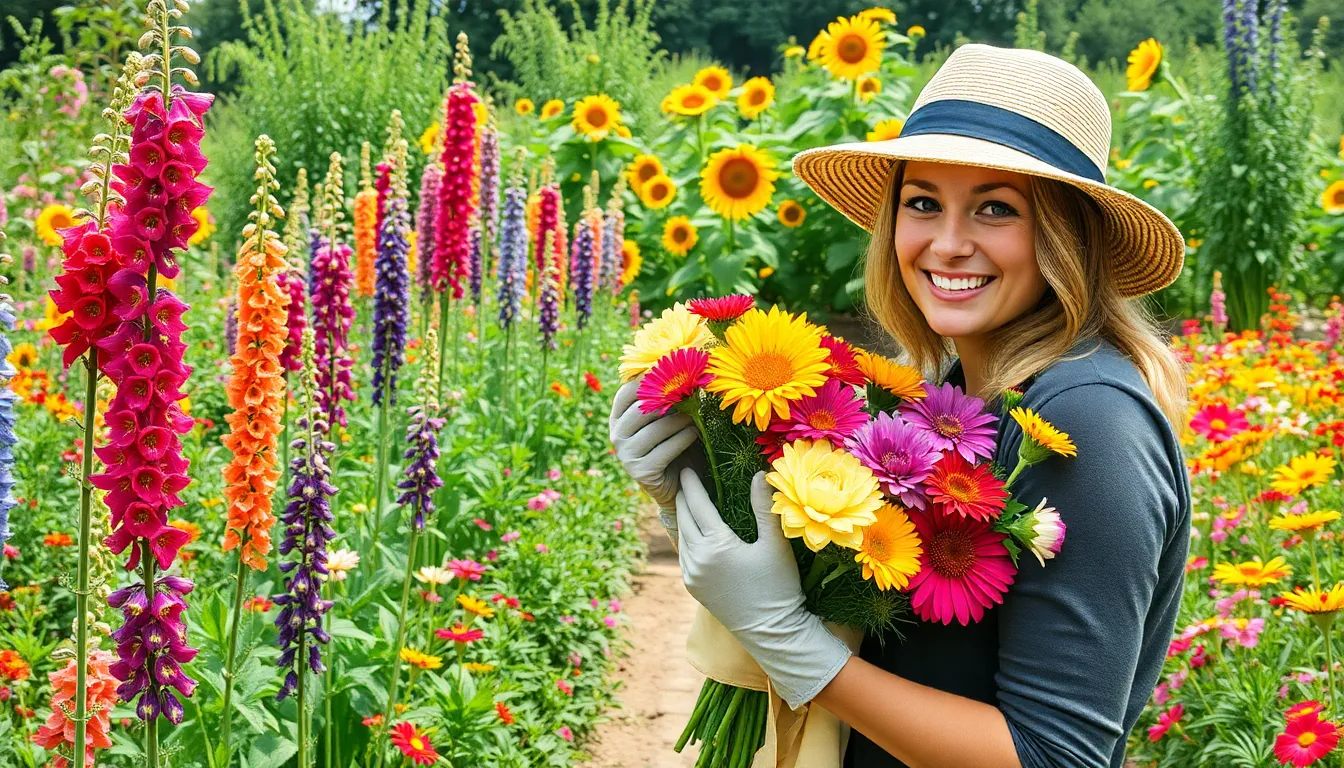
We recommend establishing a dedicated cutting garden using narrow, rectangular spaces that maximize efficiency for tending and harvesting. This design approach allows us to create beautiful arrangements while maintaining easy access for regular maintenance and flower collection.
Plant Flowers with Long Stems
Selecting varieties with tall, elegant stems transforms our cutting garden into a source of professional-quality bouquets. Snapdragons provide vertical drama with their towering spikes that reach 12-36 inches, while sunflowers create stunning focal points with stems extending up to 10 feet. Cosmos offer delicate, feathery foliage on stems that stretch 2-6 feet tall, perfect for adding texture to arrangements.
We suggest planting these tall flowers in a staggered pattern to create visual appeal while ensuring each plant receives adequate sunlight. Arranging taller varieties toward the back of garden beds prevents them from shading shorter companions. Spacing plants according to their mature width prevents overcrowding and promotes healthy stem development.
Include Fragrant Varieties
Incorporating aromatic flowers elevates our bouquets beyond visual beauty to engage multiple senses. Lavender contributes its signature calming scent while providing purple spikes that complement various color schemes. Sweet basil offers both culinary value and fragrant leaves that enhance mixed arrangements with their peppery aroma.
We recommend creating dedicated sections for herb companions like lemon balm and mint, which provide refreshing fragrances and textural contrast. These perennial herbs establish permanent fragrant zones that return year after year. Positioning fragrant plants near pathways allows us to enjoy their scents during garden maintenance and harvesting activities.
Plan for Continuous Blooms
Maintaining a steady supply of fresh flowers requires strategic succession planting throughout the growing season. We achieve this by staggering planting times for annuals every 2-3 weeks, ensuring new blooms emerge as others fade. This technique provides constant harvesting opportunities from spring through fall.
Cut-and-come-again flowers like zinnias reward regular harvesting with increased bloom production, making them essential for productive cutting gardens. We incorporate spring-blooming bulbs for early season color, followed by summer annuals and perennials that extend blooming periods. Combining early, mid, and late-season varieties creates a continuous cycle that keeps our arrangements fresh and varied throughout the year.
Design a Butterfly and Pollinator Garden
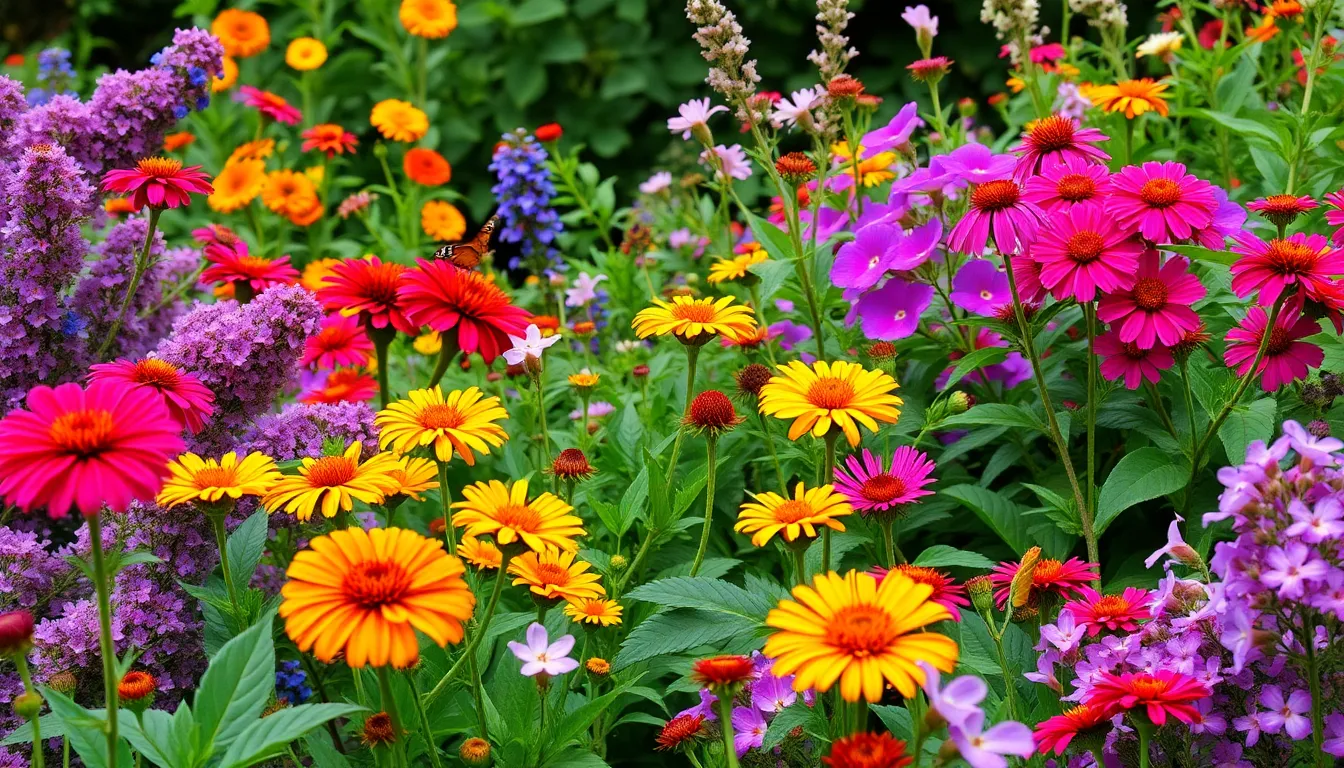
We’ll create a specialized garden space that supports butterflies and other pollinators through strategic plant selection and habitat features. This dedicated area becomes a vibrant network that benefits both our outdoor space and local wildlife populations.
Select Nectar Rich Flower Varieties
Butterfly Bush serves as the cornerstone nectar source, providing abundant food for monarchs and many other butterfly species throughout the growing season. Lantana delivers consistent nectar production during summer months, creating reliable feeding stations that attract diverse pollinator populations. Phlox offers extended nectar availability that particularly appeals to swallowtail butterflies with its long lasting blooms. Verbena attracts the widest range of butterfly species due to its extended bloom time and high nectar content.
We’ll arrange these nectar sources in clusters of three to five plants per variety to create visual impact and concentrated feeding areas. Staggering bloom times ensures continuous nectar availability from early spring through late fall, supporting pollinators throughout their active seasons.
Include Host Plants for Caterpillars
Milkweed functions as the primary food source for monarch caterpillars, making it essential for supporting complete butterfly life cycles in our garden space. Curly Parsley provides necessary nutrition for swallowtail butterfly larvae while adding culinary value to our garden design. Fennel supports swallowtail reproduction while contributing feathery texture and aromatic qualities to the industry. Rue and Dill complete the swallowtail host plant collection, ensuring adequate food sources for growing caterpillar populations.
We’ll position host plants in protected areas where caterpillars can develop safely away from high traffic zones. Dedicating 30% of our butterfly garden space to host plants ensures sufficient breeding habitat for local butterfly populations.
Create Water Sources and Shelter
Shallow dishes filled with fresh water provide essential drinking sources and help butterflies regulate their body temperature during hot weather. Birdbaths with textured surfaces offer landing spots for butterflies while serving multiple pollinator species simultaneously. Native shrubs create windbreaks and predator protection while providing roosting sites for overnight shelter.
We’ll place water sources in sunny locations where butterflies prefer to gather, refreshing them every few days to prevent mosquito breeding. Native trees establish permanent shelter structures that support butterfly populations year round while adding vertical interest to our garden design. Positioning shelter elements on the north side of our butterfly garden protects delicate flowers from harsh winds while creating microclimates for different species.
Build Raised Beds for Better Control
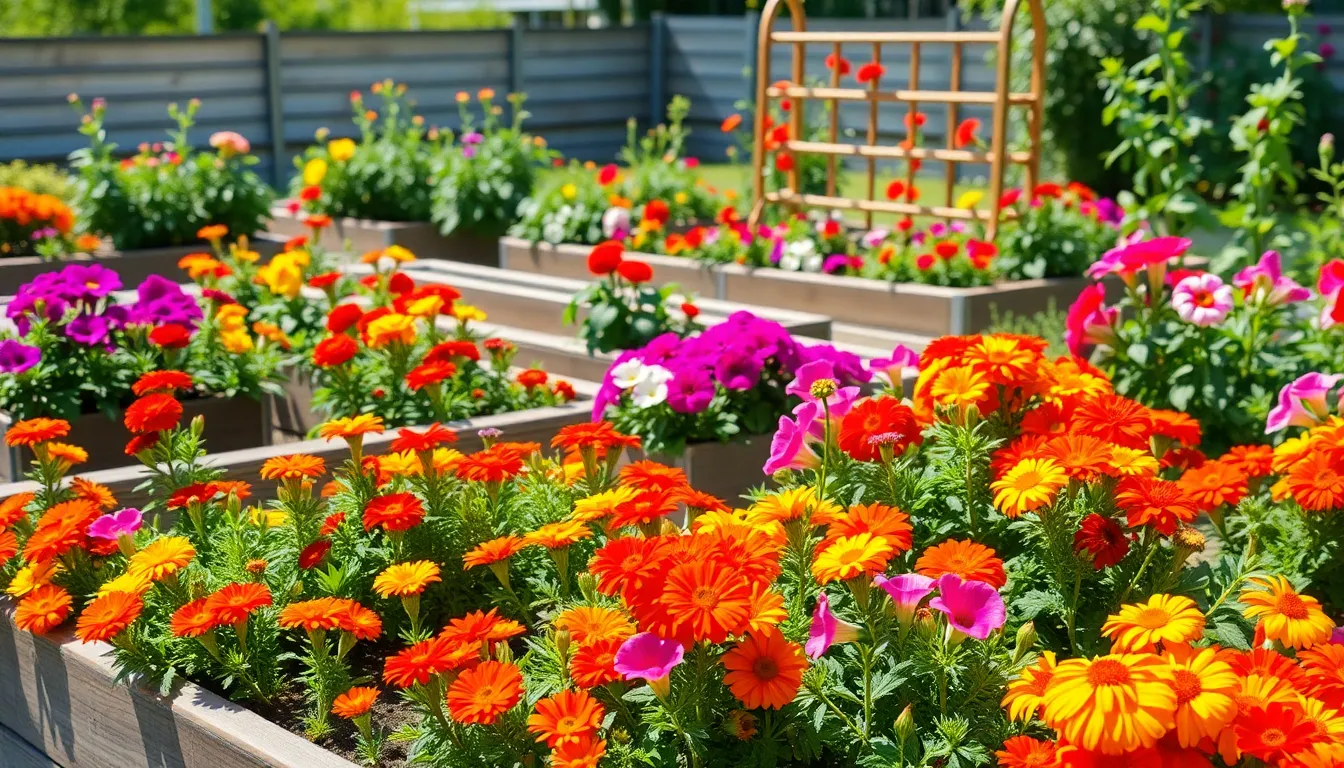
Building raised beds transforms our flower garden into a more manageable and productive space. We’ll gain superior control over growing conditions while creating an organized garden structure.
Improve Soil Quality and Drainage
Raised beds enable us to control soil pH levels and nutrient content, which significantly improves plant growth throughout our garden. We can create custom soil mixes customized to exact flower varieties, ensuring optimal growing conditions for marigolds, petunias, snapdragons, pansies, and impatiens.
Drainage becomes dramatically better in raised beds, reducing the risk of waterlogged roots and promoting healthier root systems. Well-draining soil prevents root rot and fungal diseases that commonly affect ground-level plantings.
Temperature control offers another advantage, as soil in raised beds warms up faster than ground-level soil. This enables earlier planting of flowers and extends our growing season.
Compaction issues disappear with raised beds since we never walk on the planting areas. Reduced soil compaction enhances root growth and improves water infiltration.
Define Garden Boundaries
Border planting becomes effortless when we use raised beds to create defined edges around our garden space. Strategic placement of raised beds frames our garden and adds visual structure to the industry.
Visual appeal increases as raised beds create natural boundaries between different garden areas. We can establish separate zones for annuals, perennials, and cutting flowers without blending or overcrowding.
Vertical gardening opportunities expand when we incorporate trellises or arbors into our raised bed design. This maximizes growing space and creates layered visual interest throughout the garden.
Design flexibility allows us to create geometric patterns or curved layouts that complement our home’s architecture. Raised beds serve as permanent industry features that define our outdoor space.
Make Maintenance Easier
Access becomes significantly easier for weeding and pruning when plants are elevated in raised beds. We can tend to our flowers without bending or kneeling extensively, reducing physical strain during garden maintenance.
Pest control improves as raised beds offer natural protection against ground-dwelling pests and small animals. The elevated planting surface creates a barrier that many garden pests cannot easily cross.
Watering efficiency increases since we can target water directly to plant roots without waste. Raised beds allow for better water distribution and reduce runoff compared to traditional ground-level gardens.
Organization becomes simpler when different flower varieties are contained in separate raised beds. We can easily track plant performance and adjust care routines for exact growing areas.
Incorporate Container Gardens for Flexibility
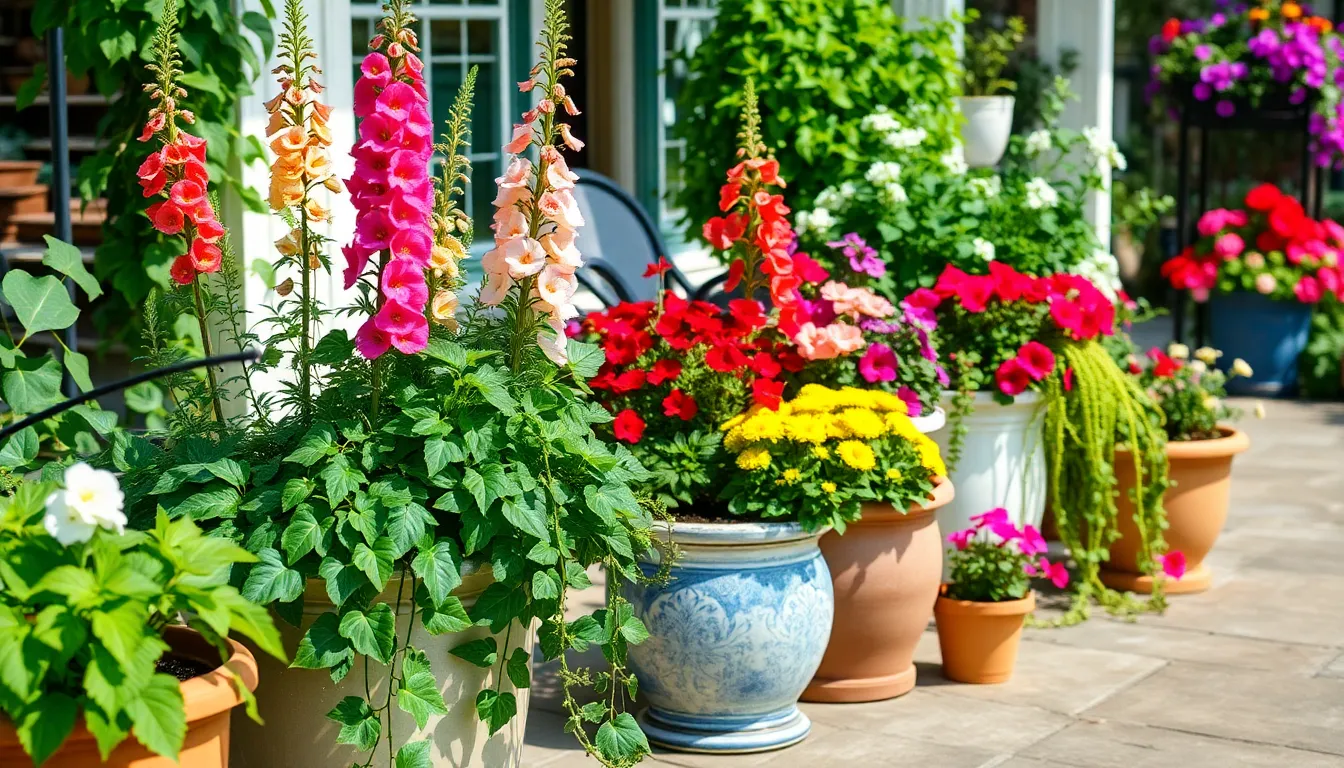
Container gardening revolutionizes how we approach flower garden design by offering unmatched versatility and creative freedom. We can customize spaces for different light conditions and create portable displays that adapt to our changing needs throughout the seasons.
Choose Appropriate Pot Sizes
Selecting the right container size directly impacts plant health and determines what varieties we can successfully grow together. Small containers under 12 inches in diameter work perfectly for bulbs, herbs, succulents, and alpine plants that have compact root systems. Larger containers accommodate more substantial plantings and allow us to create diverse mixed arrangements with multiple plant types.
We must ensure every container includes proper drainage holes to prevent waterlogging, which can quickly kill even the hardiest flowers. The container size also affects how often we’ll need to water, with smaller pots requiring more frequent attention during hot weather.
Select Portable Seasonal Displays
Portability stands as container gardening’s greatest advantage, allowing us to move displays to optimal locations as light conditions change throughout the year. Spring bulbs can brighten covered porches before being relocated to make room for vibrant summer petunias. Fall brings opportunities to showcase colorful mums, while winter pansies provide cheerful color during colder months.
We can easily swap out seasonal plantings to maintain continuous interest, ensuring our garden spaces never look bare or neglected. This flexibility means we’re not locked into permanent plant choices and can experiment with different combinations each season.
Mix and Match Different Heights
Creating visual depth requires combining plants of varying heights using the proven “Thriller, Filler, Spiller” approach. Tall dramatic plants like snapdragons or Angelonia serve as focal points, while medium sized flowers such as petunias or coleus fill in the middle spaces. Trailing plants like ivy or euphorbia cascade over container edges to complete the arrangement.
We maximize impact in limited spaces by layering these different heights strategically within each container. This approach adds complexity and professional polish to our floral displays while ensuring every plant receives adequate light and growing space.
Plant a Moon Garden for Evening Beauty
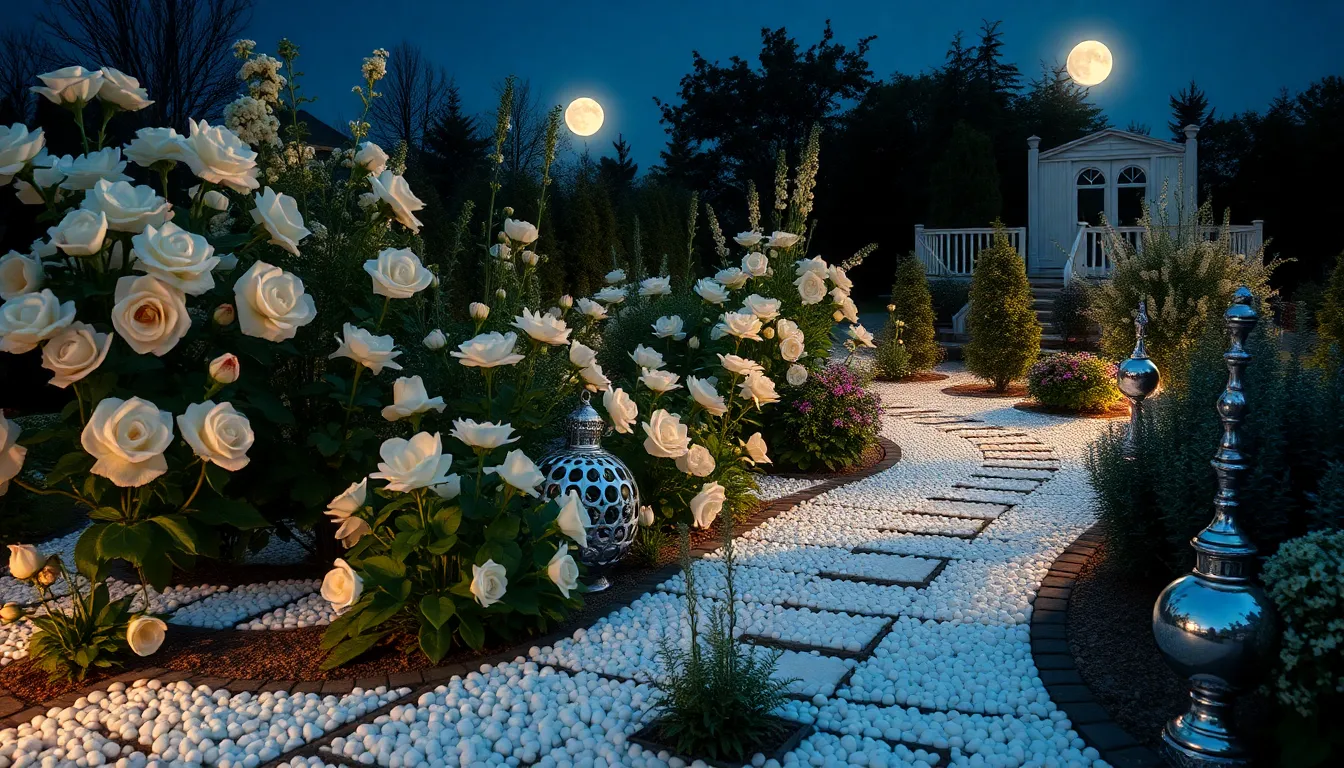
Moon gardens transform outdoor spaces into enchanting nighttime retreats that come alive after sunset. We design these magical spaces using plants that reflect moonlight and release captivating fragrances during evening hours.
Select White and Light-Colored Flowers
White and pale-colored blooms become luminous beacons under moonlight, creating stunning visual impact when darker flowers fade into shadows. We choose white varieties of popular flowers like roses, petunias, and impatiens to establish the foundation of our moon garden palette.
Silver foliage plants amplify the moonlight effect by reflecting light throughout the garden space. Dusty miller, lamb’s ear, and artemisia provide year-round structure with their distinctive silvery leaves that shimmer in low light conditions.
Variegated plants offer dual benefits by combining white markings with green foliage for daytime interest while maintaining nighttime visibility. Hostas with white edges, variegated ivy, and silver-splashed heuchera create layered textures that work beautifully in both container arrangements and industry beds.
Include Fragrant Night-Blooming Varieties
Night-blooming flowers release their strongest fragrances after dark, compensating for reduced visual appeal with intoxicating scents that drift through evening air. Four o’clocks open their trumpet-shaped blooms in late afternoon, releasing sweet perfume that attracts nocturnal pollinators like moths and sphinx beetles.
Evening primrose produces bright yellow flowers that unfurl dramatically at dusk while emitting a light, pleasant fragrance throughout the night. Moonflowers climb trellises and fences with their large white trumpet blooms that spiral open in minutes, creating a spectacular evening show accompanied by sweet vanilla scents.
Fragrant herbs enhance the sensory experience while providing practical benefits for our kitchen gardens. Night-blooming jasmine, evening stock, and nicotiana release powerful fragrances that can be detected from important distances, making them ideal anchor plants for moon garden designs.
Add Reflective Elements
Reflective materials multiply moonlight throughout the garden space, creating an ethereal glow that enhances plant visibility and overall ambiance. We incorporate white gravel pathways, light-colored stepping stones, and pale mulch to establish a foundation that captures and redirects lunar illumination.
Water features add both visual reflection and soothing sounds that complete the sensory moon garden experience. Shallow birdbaths with light-colored bowls, small fountains with white or silver accents, and decorative water bowls positioned strategically throughout the space create multiple reflection points.
Garden ornaments in silver, white, or pale colors serve as focal points while maximizing light reflection during nighttime hours. Gazing balls, white ceramic planters, and light-colored sculptures placed among plantings create additional surfaces that capture and scatter moonbeams throughout our evening sanctuary.
Create Themed Garden Sections
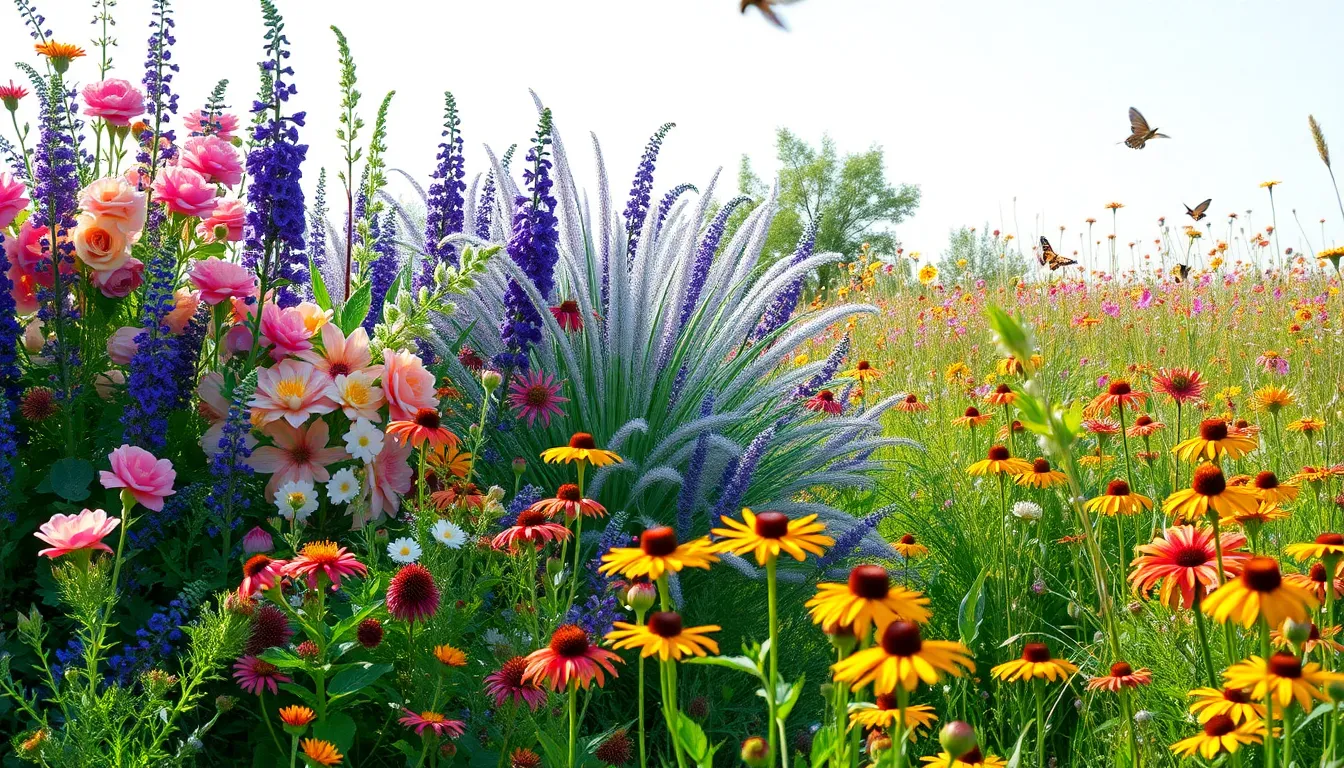
We can organize our flower garden into distinct themed sections that each provide unique aesthetic experiences and practical benefits. These specialized areas allow us to showcase different design philosophies while maintaining cohesive overall garden structure.
Design a Cottage Garden Style
Cottage gardens embrace a free-form, informal style that celebrates heirloom and fragrant flowers in romantic, overflowing displays. We achieve this charming look by selecting classic varieties like old English roses, lavender, Shasta daisies, foxgloves, and hollyhocks that create timeless appeal. Repeating plant varieties throughout the space maintains visual cohesion while preventing the informal style from appearing chaotic.
Color palette simplicity enhances the cottage garden’s effectiveness, with combinations like pink, white, and yellow providing harmonious beauty without overwhelming the senses. We layer these blooms naturally, allowing plants to intermingle and create the signature overflowing appearance that makes cottage gardens so enchanting. Fragrant varieties take priority in these sections, as their scents contribute significantly to the romantic atmosphere we’re cultivating.
Build a Modern Minimalist Display
Modern minimalist flower gardens use clean lines, restrained plant choices, and simple color schemes to create sleek, uncluttered outdoor spaces. We focus on structural plants with neat growing habits, arranging them in repetitive patterns that emphasize form over exuberant color displays. This approach creates visual impact through thoughtful restraint rather than overwhelming abundance.
Compact flowering shrubs work exceptionally well in minimalist designs, providing controlled blooms that don’t disrupt the clean aesthetic we’re pursuing. We incorporate sparse, sculptural blooms against backdrops of ornamental grasses or low hedges to maintain the sophisticated simplicity that defines this style. Negative space becomes as important as planted areas, allowing each element to make its statement without competition.
Establish a Wildflower Meadow
Wildflower meadows prioritize native flowers and grasses that thrive naturally in our local conditions while supporting biodiversity and attracting essential pollinators. We create these naturalistic displays by seeding native varieties like coneflowers, black-eyed Susans, and coreopsis that form colorful, spontaneous tapestries. This approach requires minimal maintenance once established, making it ideal for larger garden areas or busy gardeners.
Conservation benefits make wildflower meadows particularly valuable, as they contribute to local network health while providing airy, natural beauty to our landscapes. We select species that bloom at different times throughout the season, ensuring continuous color and nectar sources for butterflies, bees, and hummingbirds. These sections bring spontaneous charm to our gardens while supporting environmental stewardship through native plant cultivation.
Plan for Year-Round Interest
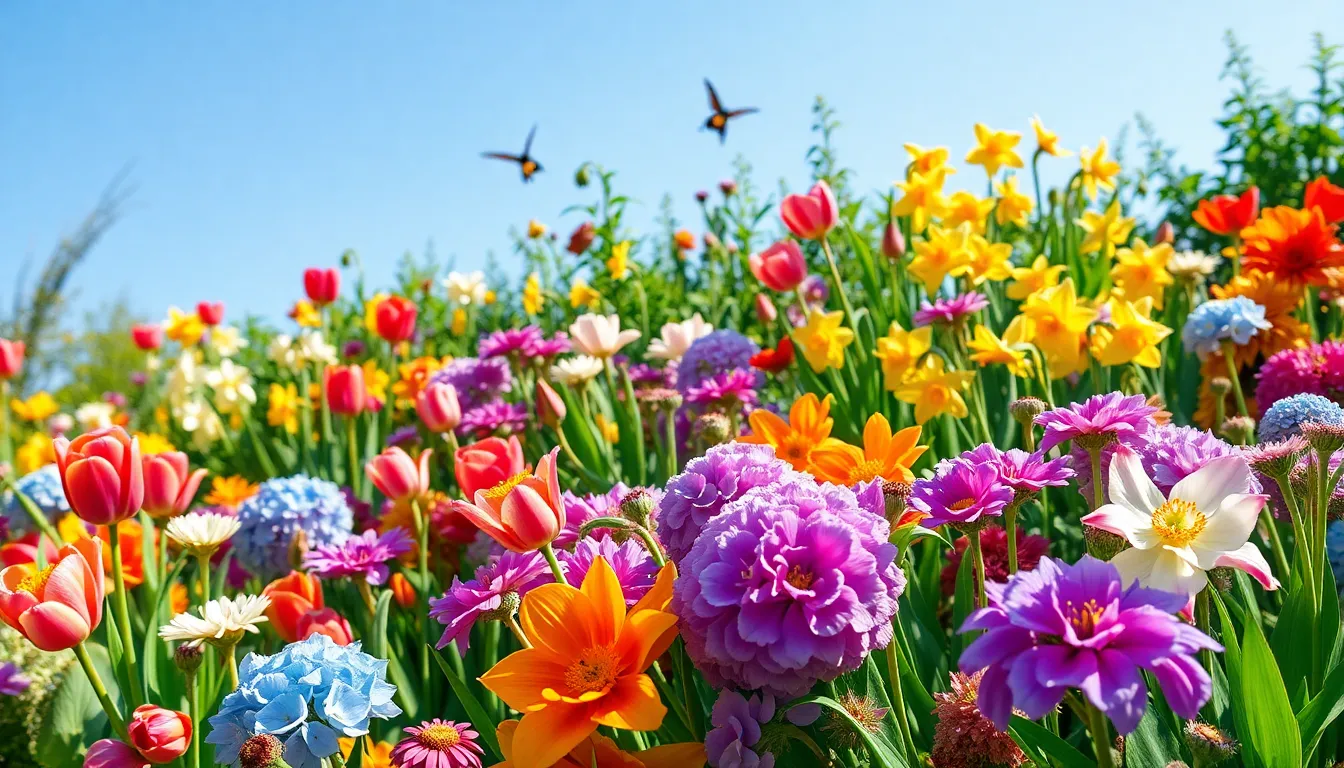
Creating a flower garden with continuous appeal requires strategic timing and plant selection. We combine evergreen trees or shrubs as structural backbone elements with perennials that bloom at different times and annuals for seasonal highlights.
Include Spring Bulbs
Tulips offer vibrant colors and early bloom times that signal winter’s end and create stunning garden displays. We plant these bulbs in fall for spectacular spring shows that range from soft pastels to bold jewel tones.
Daffodils symbolize spring with their bright yellow hues and naturalize beautifully in garden beds year after year. These hardy bulbs require minimal maintenance once established and multiply naturally to create larger displays.
Hyacinths provide fragrant and colorful blooms that often appear in early spring when gardens need revival most. We position these intensely scented flowers near pathways and seating areas where their perfume can be fully appreciated.
Crocuses emerge as early risers that often peek through snow and provide the first color of the season. These compact bulbs work perfectly in rock gardens, lawn areas, and under deciduous trees where they receive spring sun.
Add Summer Perennials
Hydrangeas produce large, showy flowers in blue, pink, or white that bloom throughout summer and provide substantial garden presence. We select varieties based on our soil pH since acidic conditions create blue blooms while alkaline soils produce pink flowers.
Cosmos create delicate, dainty blooms in pink, white, or purple that attract butterflies and beneficial insects to our gardens. These low maintenance annuals self seed readily and provide continuous color from early summer through first frost.
Echinacea demonstrates drought tolerance while attracting pollinators with their distinctive cone shaped centers and colorful petals. We appreciate these native perennials for their long bloom period and ability to thrive in challenging conditions.
Mandevilla vines bloom from early summer to fall and provide vertical interest with their climbing habit and trumpet shaped flowers. These heat loving plants work excellently on trellises, arbors, and fence lines where they receive full sun exposure.
Plant Fall-Blooming Varieties
Dahlias thrive in cooler fall temperatures and produce their most impressive blooms as summer heat subsides. We plant these tuberous perennials in late spring and enjoy their spectacular flower show from late summer through first frost.
Asters provide late season color and attract pollinators when many other flowers have finished blooming for the year. These hardy perennials offer purple, pink, and white flowers that support migrating butterflies and beneficial insects.
Marigolds brighten up gardens with warm hues and continue blooming until hard frost eliminates their vibrant displays. We use these reliable annuals as border plants and companion plants since they naturally repel certain garden pests.
Saffron crocus offers unique and vibrant autumn blooms that provide unexpected color when most bulbs remain dormant underground. These specialty bulbs require well drained soil and produce the valuable saffron spice from their distinctive red stigmas.
Conclusion
Creating your dream flower garden doesn’t have to be overwhelming when you break it down into manageable steps. We’ve covered everything from site selection and layout planning to specialized garden types that can transform any outdoor space into a vibrant sanctuary.
The key to success lies in understanding your local climate and choosing plants that’ll thrive in your exact conditions. Whether you’re drawn to a cottage garden’s romantic charm or a modern minimalist design’s clean lines there’s a style that’ll perfectly complement your home and lifestyle.
Remember that gardening is a journey of continuous learning and growth. Start with one or two ideas that excite you most and gradually expand your garden as you gain confidence and experience. With proper planning and plant selection you’ll soon have a stunning flower garden that brings joy throughout the seasons.
Frequently Asked Questions
What factors should I consider when choosing a location for my flower garden?
Consider sunlight requirements (full sun vs. partial shade), soil drainage quality, accessibility for maintenance, visibility from main areas, and clearance from utility lines. Position your garden in high-traffic areas for maximum enjoyment while ensuring you can easily reach all plants for care. Well-draining soil is essential for most flowers, though some varieties thrive in clay or sandy conditions.
How do I plan a garden layout that’s both beautiful and practical?
Use simple geometric shapes like rectangles or circles for visual appeal and easy maintenance access. Create focal points and clear pathways using materials like limestone or gravel. Plan for height variations by layering plants from short to tall, and ensure adequate spacing between plants for healthy growth and air circulation.
What’s the difference between annuals and perennials in garden planning?
Annuals complete their life cycle in one season but provide vibrant, continuous blooms all summer. Perennials return each year, offering long-term structure and cost savings, though they typically bloom for shorter periods. Combining both types ensures sustained color throughout the growing season while building a stable garden foundation.
How do I choose flowers that will thrive in my climate?
Use the USDA Plant Hardiness Zone Map to identify your zone and select appropriate plants. Research hardy perennials like coneflowers and daylilies that withstand local climate extremes. Consider native plants, which require minimal maintenance and support local ecosystems. Choose annuals like marigolds and petunias for reliable summer performance in most climates.
What is a cutting garden and how do I create one?
A cutting garden is designed specifically for harvesting flowers for indoor arrangements. Use narrow, rectangular spaces for efficient tending and plant flowers with long stems like snapdragons, sunflowers, and cosmos. Practice succession planting by staggering planting times to ensure continuous blooms, and choose cut-and-come-again varieties like zinnias for repeated harvests.
How can I design a garden that attracts butterflies and pollinators?
Plant nectar-rich flowers like Butterfly Bush, Lantana, and Phlox in clusters for concentrated feeding areas. Include host plants such as Milkweed for caterpillar breeding. Create shallow water sources and provide shelter with native shrubs. Ensure continuous blooms throughout the season by selecting plants with staggered flowering times to support pollinators consistently.
What are the benefits of using raised beds for flower gardens?
Raised beds offer better control over soil quality and drainage, allowing for customized soil mixes. They provide improved temperature control, extending the growing season and promoting healthier root systems. Maintenance becomes easier with reduced physical strain, better pest control, and more efficient watering. They also create defined boundaries and enhance visual appeal.
How does container gardening work for flowers?
Container gardening offers flexibility to move plants based on light conditions and seasonal changes. Select appropriate pot sizes for different plants and ensure proper drainage. Use the “Thriller, Filler, Spiller” technique, combining upright focal plants, mid-height fillers, and trailing spillers for layered arrangements. This approach allows easy seasonal display swaps.
What is a moon garden and how do I create one?
A moon garden features white and light-colored flowers that reflect moonlight, creating enchanting nighttime displays. Include silver foliage plants like dusty miller and fragrant night-blooming varieties such as four o’clocks and moonflowers. Add reflective elements like white gravel pathways and water features to enhance the moonlight effect and create magical evening ambiance.
How can I ensure my flower garden has year-round interest?
Incorporate structural evergreen elements alongside perennials with staggered bloom times. Plant spring bulbs like tulips and daffodils for early color, summer perennials like hydrangeas and cosmos for peak season, and fall bloomers like dahlias and asters for extended appeal. Include plants with interesting foliage, seed heads, or bark for winter interest.

